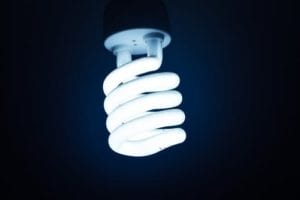Written by Joyce Smith, BS. This study finds that cyclic illumination of low light intensity (200 lux) for 14 days produced retinal degeneration; however, shielding 60% of damaging blue light may protect retinas from light damage thus providing a method for protecting eyes from the damaging effects of blue light.
 Shifting to more energy-efficient white light emitting bulbs (LEDs) with longer life spans 1 may be damaging to our health. Among the concerns are the phototoxic damage to the retina of the eye as well sleep issues due to disruption of our circadian rhythms. 2 These LEDs emit more blue light that peaks at 440-460 nm than conventional lamps 3 and at wavelengths of 400-500 nm, LEDs have been shown to produce photochemical damage to the retina of the eye. 4
Shifting to more energy-efficient white light emitting bulbs (LEDs) with longer life spans 1 may be damaging to our health. Among the concerns are the phototoxic damage to the retina of the eye as well sleep issues due to disruption of our circadian rhythms. 2 These LEDs emit more blue light that peaks at 440-460 nm than conventional lamps 3 and at wavelengths of 400-500 nm, LEDs have been shown to produce photochemical damage to the retina of the eye. 4
In this study, Liu et al 5 used a rat model, Sprague-Dawley rats (SD rats), to investigate the retinal photochemical damage caused by LEDs and to evaluate how much eye protection is obtained from blue light-shielding films with different levels of shielding. SD rats were randomly divided into five groups (n=12 per group):
- Group I- control group
- Group II – white LED illumination with no shielding
- Groups III- white LED illumination combined with shielding of blue light of wavelength 440 nm at 40%
- Group IV- white LED illumination combined with shielding of blue light of wavelength 440 nm at 60%
- Group V- white LED illumination combined with shielding of blue light of wavelength 440 nm at 80%
All rats were kept in the dark for 14 days to eliminate any lighting effects acquired from their previous rearing environments. After 14 days of adapting to the dark, they were exposed to 14 days of cyclic illumination of low light intensity (200 lux) involving a 12-hour dark/ 12-hour light cyclic routine. Rats were finally returned to the dark environment for 14 days of recovery. They were then sacrificed in three groups of four per group by lethal injection with sodium pentobarbital. All animals underwent electroretinography (ERG), hematoxylin-eosin (H&E) staining, immunohistochemical (IHC) staining, and transmission electron microscopy (TEM) observation after 14 days of dark-adaptation before illumination, after 14 days of cyclic illumination, and after 14 days of darkness for recovery following illumination.
Researchers found that a cyclic illumination of low light intensity (200 lux) for 14 days produced retinal degeneration in SD rats; however, the protective effect of the shielding films was obvious, especially when more than 60% of the blue light was shielded. In fact, the authors feel that 60% shielding of blue light of wavelength 440 nm (bandwidth 20 nm) protected against retinal damage and may be sufficient since there was no significant difference between shielding at 60% and 80%.
Additional studies are recommended using human retina to determine the ideal shielding rated for humans given that their biology and physical environments are very different from that of rats.
Source: Liu, Xin, Qi Zhou, Hui Lin, Jinzhen Wu, Zoning Wu, Shen Qu, and Yeanling Bi. “The Protective Effects of Blue Light-Blocking Films with Different Shielding Rates: A Rat Model Study.” Translational vision science & technology 8, no. 3 (2019): 19-19.
© 2019 the Authors. This is an open access study licensed under a Creative Commons Attribution-Noncommercial-No Derivatives 4.0 International License.
Click here to read the full text study.
Posted July 29, 2019.
Joyce Smith, BS, is a degreed laboratory technologist. She received her bachelor of arts with a major in Chemistry and a minor in Biology from the University of Saskatchewan and her internship through the University of Saskatchewan College of Medicine and the Royal University Hospital in Saskatoon, Saskatchewan. She currently resides in Bloomingdale, IL.
References:
- Pawson SM, Bader M-F. LED lighting increases the ecological impact of light pollution irrespective of color temperature. Ecological Applications. 2014;24(7):1561-1568.
- Revell VL, Barrett DC, Schlangen LJ, Skene DJ. Predicting human nocturnal nonvisual responses to monochromatic and polychromatic light with a melanopsin photosensitivity function. Chronobiology international. 2010;27(9-10):1762-1777.
- Behar-Cohen F, Martinsons C, Viénot F, et al. Light-emitting diodes (LED) for domestic lighting: any risks for the eye? Progress in retinal and eye research. 2011;30(4):239-257.
- Wu J, Seregard S, Algvere PV. Photochemical damage of the retina. Survey of ophthalmology. 2006;51(5):461-481.
- Liu X, Zhou Q, Lin H, et al. The Protective Effects of Blue Light-Blocking Films With Different Shielding Rates: A Rat Model Study. Translational vision science & technology. 2019;8(3):19-19.
